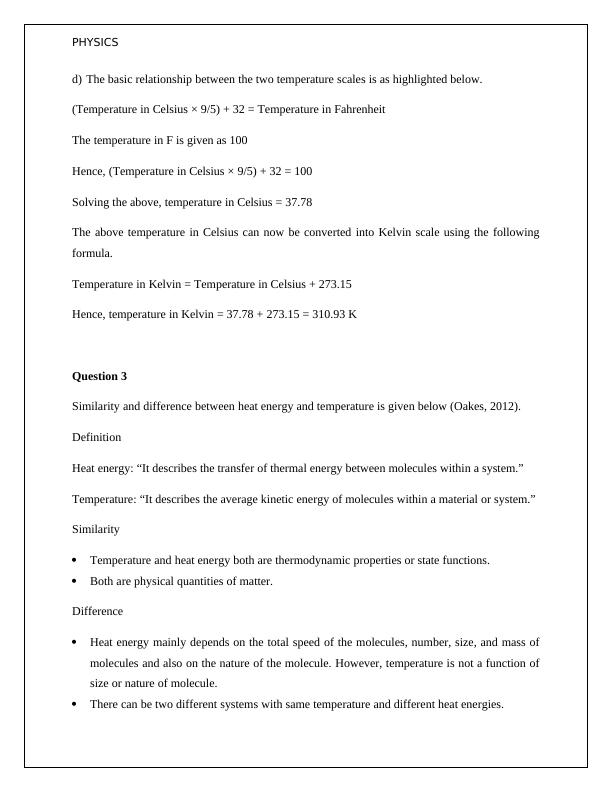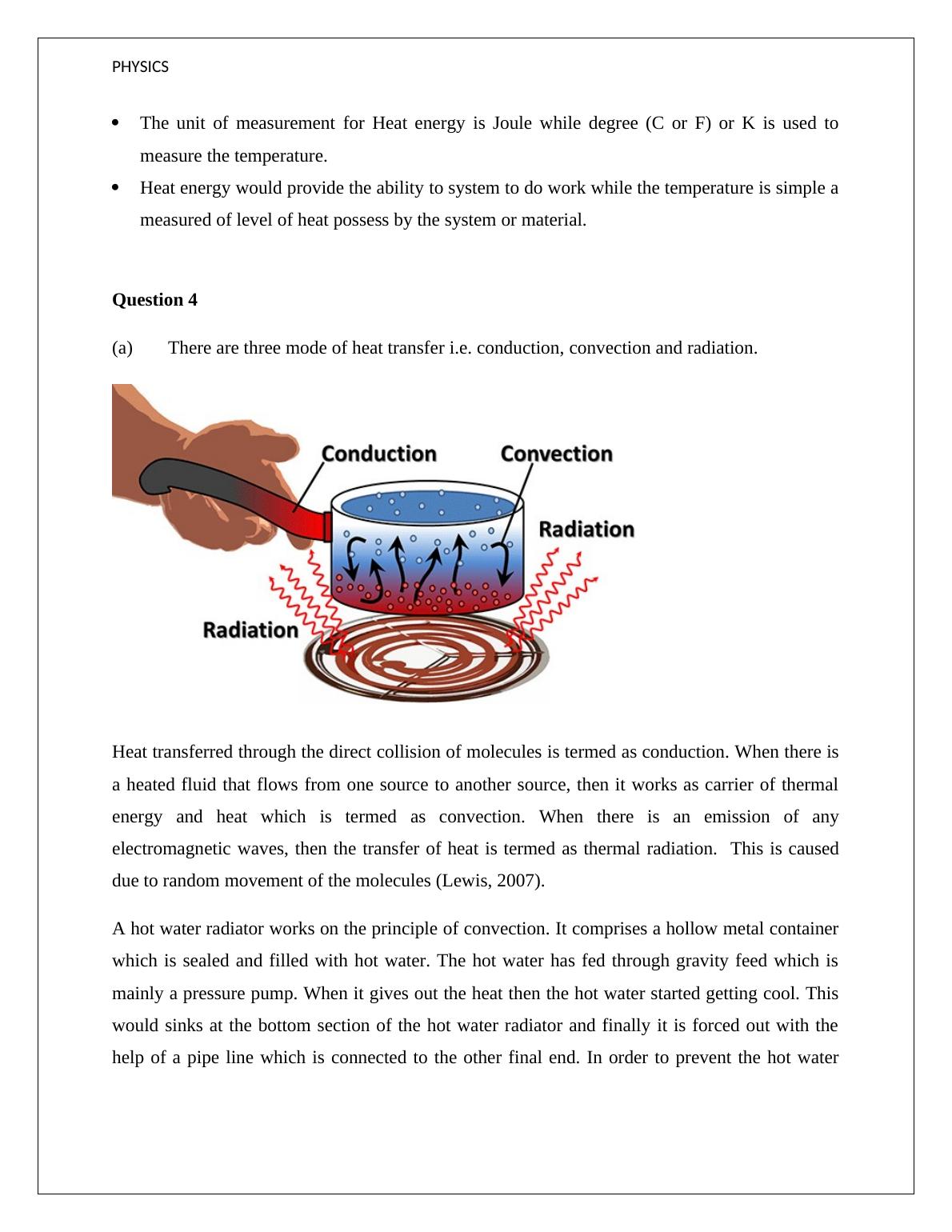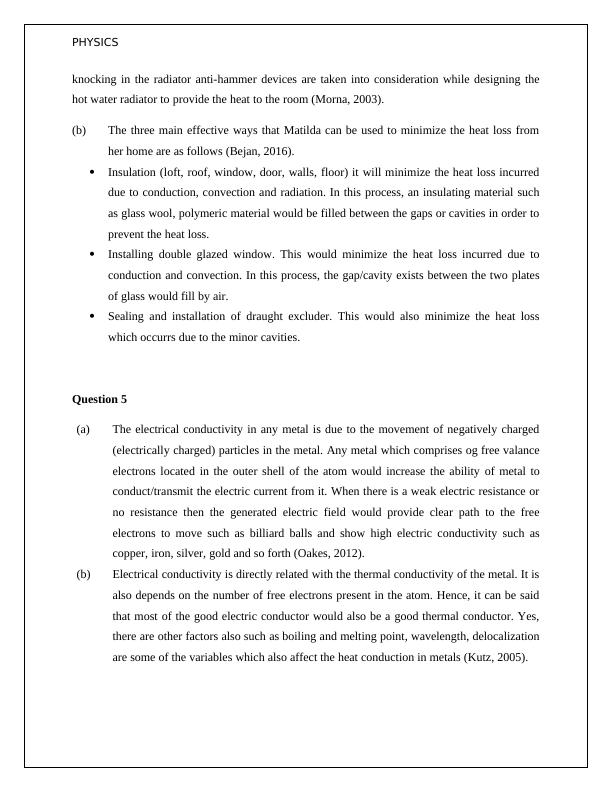Report on Physics Practical
Added on 2020-04-15
21 Pages3167 Words52 Views
PHYSICS
STUDENT ID:
[Pick the date]
STUDENT ID:
[Pick the date]

PHYSICS
Question 1
a) A basic thermometer consists of a liquid measure in the form of alcohol, mercury etc. which
is held in a glass tube and vacuum sealed. Based on the underlying temperature, this liquid
tends to expand or cool which forms the basis of thermometer. Calibration of thermometer is
essential so that the reading in the scale of the thermometer actually represents the
temperature. The calibration of thermometer is usually carried out using the reference points
that relate to the 1000C and 00C that tend to serve as reference points based on which the
marking on the scale are engraved. The range of readings represented varies with the use of
the underlying thermometer and after the scratching of the numbers, a hydrofluoric acid dip is
provided for sealing the engravings (Bejan, 2016).
b) i) Ice point is known as the freezing point whereas steam point is known as boiling point in
thermodynamics.
ii) The 122 F corresponds to 500C on the thermometer.
iii) The number 80 on temperature would correspond to 26.670C.
Question 2
a) Absolute zero in layman terms refers to the coldest temperature that can be achieved
theoretically. As a result, it is not possible to cool any object to a lower temperature.
b) “Triple point is the particular temperature and pressure at which the solid, liquid and gaseous
phases of a given substance are all at equilibrium with one another”
The triple point of water comes out to be 0.010 C or 273.16K
c) Similarities and differences between Celsius and Kelvin scales are given below (Kutz, 2005).
Definition
Celsius: The temperature scale on which 0° C means melting point (MP) of ice and 100° Cmean
boiling point (BP) of water.
Question 1
a) A basic thermometer consists of a liquid measure in the form of alcohol, mercury etc. which
is held in a glass tube and vacuum sealed. Based on the underlying temperature, this liquid
tends to expand or cool which forms the basis of thermometer. Calibration of thermometer is
essential so that the reading in the scale of the thermometer actually represents the
temperature. The calibration of thermometer is usually carried out using the reference points
that relate to the 1000C and 00C that tend to serve as reference points based on which the
marking on the scale are engraved. The range of readings represented varies with the use of
the underlying thermometer and after the scratching of the numbers, a hydrofluoric acid dip is
provided for sealing the engravings (Bejan, 2016).
b) i) Ice point is known as the freezing point whereas steam point is known as boiling point in
thermodynamics.
ii) The 122 F corresponds to 500C on the thermometer.
iii) The number 80 on temperature would correspond to 26.670C.
Question 2
a) Absolute zero in layman terms refers to the coldest temperature that can be achieved
theoretically. As a result, it is not possible to cool any object to a lower temperature.
b) “Triple point is the particular temperature and pressure at which the solid, liquid and gaseous
phases of a given substance are all at equilibrium with one another”
The triple point of water comes out to be 0.010 C or 273.16K
c) Similarities and differences between Celsius and Kelvin scales are given below (Kutz, 2005).
Definition
Celsius: The temperature scale on which 0° C means melting point (MP) of ice and 100° Cmean
boiling point (BP) of water.

PHYSICS
Kelvin: It is an absolute temperature scale on which 0 K means -273.15 ° C (absolute zero) and
273.15 K means 0 ° C .
Similarities
Both are used to represent the temperature.
Both the scales are part of SI unit system.
One formula can be used to change the temperature scale from Celsius to Kelvin i.e.
T ( K )=273.15+T ( ° C )
Both scales are precisely the same.
Differences
Kelvin scale is based on the molecular energy which defines the extremes of cold and hot
while Celsius scale is based on the MP and BP of water under standard normal atmospheric
conditions.
Kelvin scale is represented as K while Celsius scale is represented as ° C .
For scientific work Kelvin scale is more preferable than Celsius scale.
Zero degrees Celsius represent the MP of ice while the zero Kelvin means absolute zero.
Kelvin: It is an absolute temperature scale on which 0 K means -273.15 ° C (absolute zero) and
273.15 K means 0 ° C .
Similarities
Both are used to represent the temperature.
Both the scales are part of SI unit system.
One formula can be used to change the temperature scale from Celsius to Kelvin i.e.
T ( K )=273.15+T ( ° C )
Both scales are precisely the same.
Differences
Kelvin scale is based on the molecular energy which defines the extremes of cold and hot
while Celsius scale is based on the MP and BP of water under standard normal atmospheric
conditions.
Kelvin scale is represented as K while Celsius scale is represented as ° C .
For scientific work Kelvin scale is more preferable than Celsius scale.
Zero degrees Celsius represent the MP of ice while the zero Kelvin means absolute zero.

PHYSICS
d) The basic relationship between the two temperature scales is as highlighted below.
(Temperature in Celsius × 9/5) + 32 = Temperature in Fahrenheit
The temperature in F is given as 100
Hence, (Temperature in Celsius × 9/5) + 32 = 100
Solving the above, temperature in Celsius = 37.78
The above temperature in Celsius can now be converted into Kelvin scale using the following
formula.
Temperature in Kelvin = Temperature in Celsius + 273.15
Hence, temperature in Kelvin = 37.78 + 273.15 = 310.93 K
Question 3
Similarity and difference between heat energy and temperature is given below (Oakes, 2012).
Definition
Heat energy: “It describes the transfer of thermal energy between molecules within a system.”
Temperature: “It describes the average kinetic energy of molecules within a material or system.”
Similarity
Temperature and heat energy both are thermodynamic properties or state functions.
Both are physical quantities of matter.
Difference
Heat energy mainly depends on the total speed of the molecules, number, size, and mass of
molecules and also on the nature of the molecule. However, temperature is not a function of
size or nature of molecule.
There can be two different systems with same temperature and different heat energies.
d) The basic relationship between the two temperature scales is as highlighted below.
(Temperature in Celsius × 9/5) + 32 = Temperature in Fahrenheit
The temperature in F is given as 100
Hence, (Temperature in Celsius × 9/5) + 32 = 100
Solving the above, temperature in Celsius = 37.78
The above temperature in Celsius can now be converted into Kelvin scale using the following
formula.
Temperature in Kelvin = Temperature in Celsius + 273.15
Hence, temperature in Kelvin = 37.78 + 273.15 = 310.93 K
Question 3
Similarity and difference between heat energy and temperature is given below (Oakes, 2012).
Definition
Heat energy: “It describes the transfer of thermal energy between molecules within a system.”
Temperature: “It describes the average kinetic energy of molecules within a material or system.”
Similarity
Temperature and heat energy both are thermodynamic properties or state functions.
Both are physical quantities of matter.
Difference
Heat energy mainly depends on the total speed of the molecules, number, size, and mass of
molecules and also on the nature of the molecule. However, temperature is not a function of
size or nature of molecule.
There can be two different systems with same temperature and different heat energies.

PHYSICS
The unit of measurement for Heat energy is Joule while degree (C or F) or K is used to
measure the temperature.
Heat energy would provide the ability to system to do work while the temperature is simple a
measured of level of heat possess by the system or material.
Question 4
(a) There are three mode of heat transfer i.e. conduction, convection and radiation.
Heat transferred through the direct collision of molecules is termed as conduction. When there is
a heated fluid that flows from one source to another source, then it works as carrier of thermal
energy and heat which is termed as convection. When there is an emission of any
electromagnetic waves, then the transfer of heat is termed as thermal radiation. This is caused
due to random movement of the molecules (Lewis, 2007).
A hot water radiator works on the principle of convection. It comprises a hollow metal container
which is sealed and filled with hot water. The hot water has fed through gravity feed which is
mainly a pressure pump. When it gives out the heat then the hot water started getting cool. This
would sinks at the bottom section of the hot water radiator and finally it is forced out with the
help of a pipe line which is connected to the other final end. In order to prevent the hot water
The unit of measurement for Heat energy is Joule while degree (C or F) or K is used to
measure the temperature.
Heat energy would provide the ability to system to do work while the temperature is simple a
measured of level of heat possess by the system or material.
Question 4
(a) There are three mode of heat transfer i.e. conduction, convection and radiation.
Heat transferred through the direct collision of molecules is termed as conduction. When there is
a heated fluid that flows from one source to another source, then it works as carrier of thermal
energy and heat which is termed as convection. When there is an emission of any
electromagnetic waves, then the transfer of heat is termed as thermal radiation. This is caused
due to random movement of the molecules (Lewis, 2007).
A hot water radiator works on the principle of convection. It comprises a hollow metal container
which is sealed and filled with hot water. The hot water has fed through gravity feed which is
mainly a pressure pump. When it gives out the heat then the hot water started getting cool. This
would sinks at the bottom section of the hot water radiator and finally it is forced out with the
help of a pipe line which is connected to the other final end. In order to prevent the hot water

PHYSICS
knocking in the radiator anti-hammer devices are taken into consideration while designing the
hot water radiator to provide the heat to the room (Morna, 2003).
(b) The three main effective ways that Matilda can be used to minimize the heat loss from
her home are as follows (Bejan, 2016).
Insulation (loft, roof, window, door, walls, floor) it will minimize the heat loss incurred
due to conduction, convection and radiation. In this process, an insulating material such
as glass wool, polymeric material would be filled between the gaps or cavities in order to
prevent the heat loss.
Installing double glazed window. This would minimize the heat loss incurred due to
conduction and convection. In this process, the gap/cavity exists between the two plates
of glass would fill by air.
Sealing and installation of draught excluder. This would also minimize the heat loss
which occurrs due to the minor cavities.
Question 5
(a) The electrical conductivity in any metal is due to the movement of negatively charged
(electrically charged) particles in the metal. Any metal which comprises og free valance
electrons located in the outer shell of the atom would increase the ability of metal to
conduct/transmit the electric current from it. When there is a weak electric resistance or
no resistance then the generated electric field would provide clear path to the free
electrons to move such as billiard balls and show high electric conductivity such as
copper, iron, silver, gold and so forth (Oakes, 2012).
(b) Electrical conductivity is directly related with the thermal conductivity of the metal. It is
also depends on the number of free electrons present in the atom. Hence, it can be said
that most of the good electric conductor would also be a good thermal conductor. Yes,
there are other factors also such as boiling and melting point, wavelength, delocalization
are some of the variables which also affect the heat conduction in metals (Kutz, 2005).
knocking in the radiator anti-hammer devices are taken into consideration while designing the
hot water radiator to provide the heat to the room (Morna, 2003).
(b) The three main effective ways that Matilda can be used to minimize the heat loss from
her home are as follows (Bejan, 2016).
Insulation (loft, roof, window, door, walls, floor) it will minimize the heat loss incurred
due to conduction, convection and radiation. In this process, an insulating material such
as glass wool, polymeric material would be filled between the gaps or cavities in order to
prevent the heat loss.
Installing double glazed window. This would minimize the heat loss incurred due to
conduction and convection. In this process, the gap/cavity exists between the two plates
of glass would fill by air.
Sealing and installation of draught excluder. This would also minimize the heat loss
which occurrs due to the minor cavities.
Question 5
(a) The electrical conductivity in any metal is due to the movement of negatively charged
(electrically charged) particles in the metal. Any metal which comprises og free valance
electrons located in the outer shell of the atom would increase the ability of metal to
conduct/transmit the electric current from it. When there is a weak electric resistance or
no resistance then the generated electric field would provide clear path to the free
electrons to move such as billiard balls and show high electric conductivity such as
copper, iron, silver, gold and so forth (Oakes, 2012).
(b) Electrical conductivity is directly related with the thermal conductivity of the metal. It is
also depends on the number of free electrons present in the atom. Hence, it can be said
that most of the good electric conductor would also be a good thermal conductor. Yes,
there are other factors also such as boiling and melting point, wavelength, delocalization
are some of the variables which also affect the heat conduction in metals (Kutz, 2005).

End of preview
Want to access all the pages? Upload your documents or become a member.
Related Documents
(PDF) Thermofluids Laboratory: Heat Transfer Experimentlg...
|15
|1629
|305
Temperature and Heat Question Answer 2022lg...
|8
|1324
|14
What is global atmospheric circulation?lg...
|9
|2073
|31
